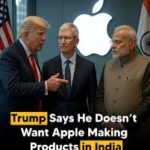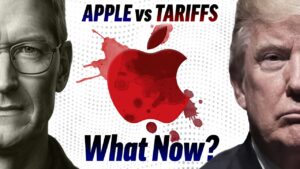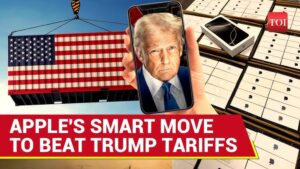Apple’s manufacturing Power:
In an escalating split between U.S. President Donald Trump and Apple CEO Tim Cook, Trump has threatened to slap 25% tariffs on iPhones that are sold but not manufactured in the U.S. As a result, Apple’s top store has seen a beating in the U.S. market. But it’s not the first warning of this kind, though. Just a few days ago, Trump has again asked Tim Cook to stop building more manufacturing plants in India.
But why is this significant?

Now, this move comes at a time when Trump’s tariffs have already pushed Apple to shift its production from China to India. And during an earnings call, CEO Tim Cook has already declared that the company aims to produce the majority of iPhones being sold in the U.S. in the June quarter, right here in this country.
Now, this is not all. The company is also eyeing to move 25% of its total iPhone production to India in the coming years. Over the past five years, India has emerged as one of the biggest manufacturing hubs of Apple iPhones, and the government continues to encourage Apple to produce more.
In the last financial year, India churned out iPhones worth $22 billion, and is responsible for nearly 20% of the total iPhone production. Experts have said that if iPhones were to be manufactured in the U.S., the cost of iPhone could see an almost 3x rise.
So let’s take a look and let’s actually see what has been said so far. Apple has decided to source all and produce all its mobile phones in India in the years to come.
The telecom equipment market is rising manifold. Our sales of mobile phones alone is worth 200,000 crores in the last fiscal year, which means we are talking about close to about $24 billion. And our telecom equipment market, from sales exports of those to 8,500,000 crores has risen to almost 20,000 crores, which is 3 billion dollars.
Apple, as you know, is coming in. And I had a little problem with Tim Cook yesterday.
I said to him, Tim, you’re my friend, actually. You’re very good. You’re coming in with 500 billion dollars. But now you’re building all over India. I don’t want you building in India. You can build in India, if you want, to take care of India.
Because India is one of the highest tariff nations in the world. It’s very hard to sell it to India. And they offered us a deal where basically they’re willing to literally charge us no tariff. So we go for the highest tariff you could do business in India. We’re not even a top 30 in India because the tariff is so high. To a point where they’ve actually told us, I assume you do, I was glad you were working on that also, that there will be no tariff.
But when you said that to Democrats, they’re the highest. And now they’re saying no tariff. I’m now joined by my guest, Nagaran Doraiswamy, Managing Partner and Founder at IdeaSpring Capital. Thank you so much for your time, Nagaran.
This is really good news for you. Apple is now witnessing Trump’s latest standoff with his firing on Apple and Tim Cook. But let me understand this. Apple produces 15% of the Google iPhones in India, placing around 2 lakh jobs.
So how is this shift shaping India’s position as a Google manufacturing hub? And what challenges might that pose for you to saving this momentum?
I’m going to get into that issue.What we typically do in software where you can quickly move things because you already know nothing in terms of access. I think the manufacturing is very, very arbitrary. Including, you can reverse check, some may change.
It’s just a whole bunch of things that need to happen. So I think anything happening overnight is almost ruled out. It will take time. And I don’t know how we’re going to be able to get new evidence into, how we’re going to be able to get new evidence to detect our manufacturing load. It has to take time. So we also went into the why of this.
I’m going to ask you another why now. So India has emerged with a few alternatives to sign up for Apple’s supply chain. What unique advantages does India offer? Skin labor, infrastructure, policy intensity, etc. Attractive companies like Apple. And how do you think you would carry someone to other countries?
 So I think you could… India has made progress. We are now moving away from just being services to actually product companies. So there are a lot of manufacturing that we’re doing now. We’re moving with people.
So I think you could… India has made progress. We are now moving away from just being services to actually product companies. So there are a lot of manufacturing that we’re doing now. We’re moving with people.
We’re doing what we’ve got.I am going to fly to India to manufacture everything that goes on in India. I am going abroad in a detailed process, in a detailed country. And you know, in my own point of view, I have been in a lot of companies where I have developed a huge number of products. So I think we are already on the path.
So we will continue this journey no matter what. But having the ability to manufacture the Apple products, it is really interesting in India quite well.
And then we have the OEM industry, also geland manufacturing. And the necessary skills that you require to do it, you know, go after a path. And you can start with anything as you see it. And you know, if you have a path, you have to ask that. But before that, you have to know how manufacturing of products works. So I think in our journey, this is still important.
So again, you can do everything you can to hold on to these kinds of contracts that you can get to manufacture to the world. But that is a much bigger game, I know. I think the world has been waiting and watching it. So almost like everything in India is set in a box, a box that is professional, social or a press conference. Please tell us about your party.
As a venture capitalist, you support India’s tech startup.
How can these tariffs affect the broader tech startup ecosystem in India, particularly those involved in electronics, confidence, or even services that are linked to app or supply chain?
So, what I mean by the software side, we are not getting that far yet, because the size of the ecosystem is mostly digital products. But, as we start to develop more and more products, especially software products, of course, the cost will come to an issue. But, I think India will still be, compared to other parts of the world, will still be very, very cost conservative.
So, again, by the time we are in the early stages of development, I know that the size is not going to make much of a difference, but as the larger companies start getting bigger, as the ecosystem starts getting larger, I think that’s when we’ll start seeing the impact of it.
Thank you. Alright, thank you so much, Tararus, for all the short updates and sharing your perspective and your insights. As the July 2025 deadline moves, I think your perspective has underscored the need for strategic resilience in India’s tech ecosystem.
So, all of us here will be watching closely, as you said, David, and watching how these negotiations unfold and what they mean for global supply chains. We thank you so much for joining us, and we look forward to more discussions on India-based manufacturing power.
